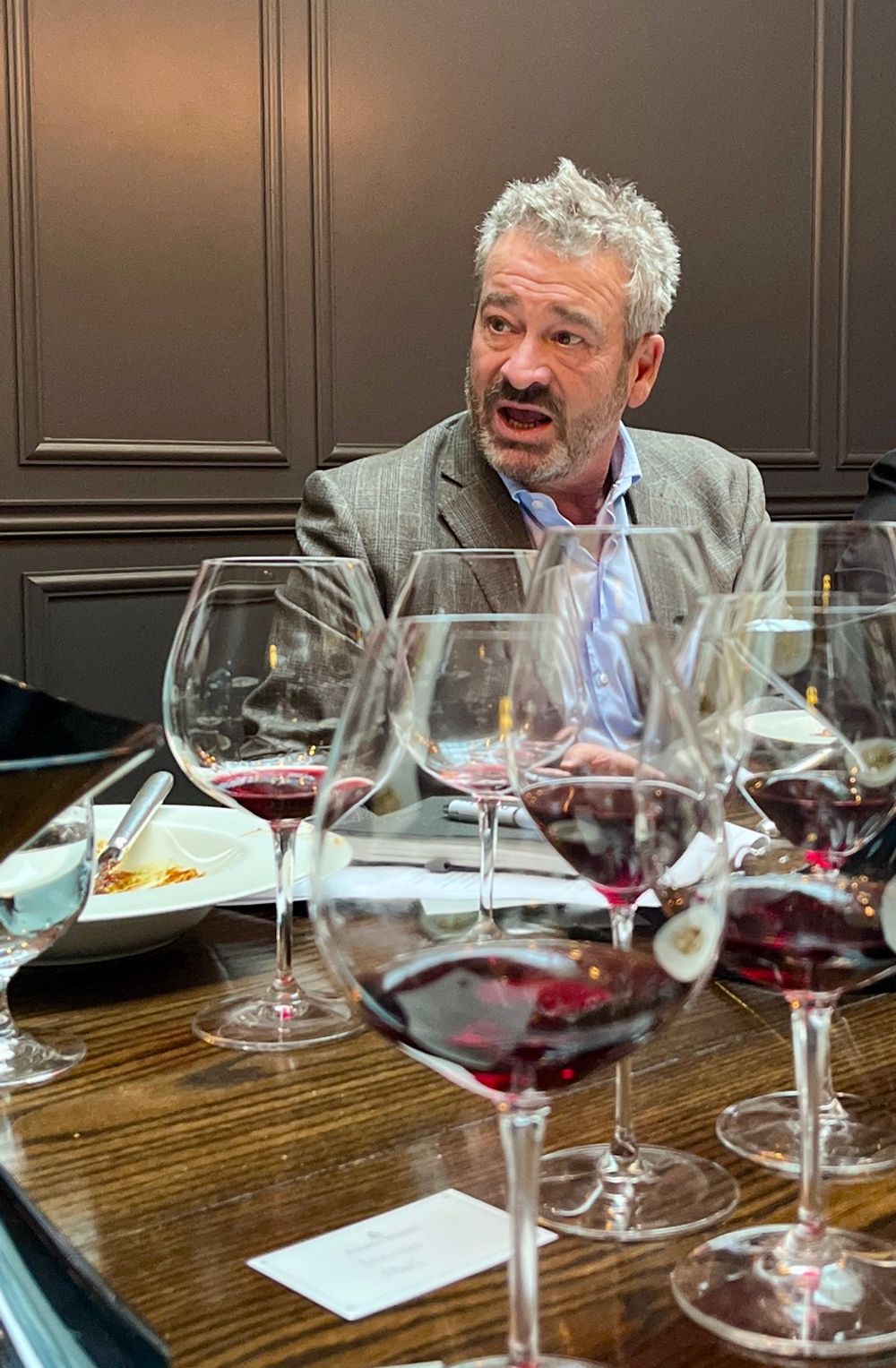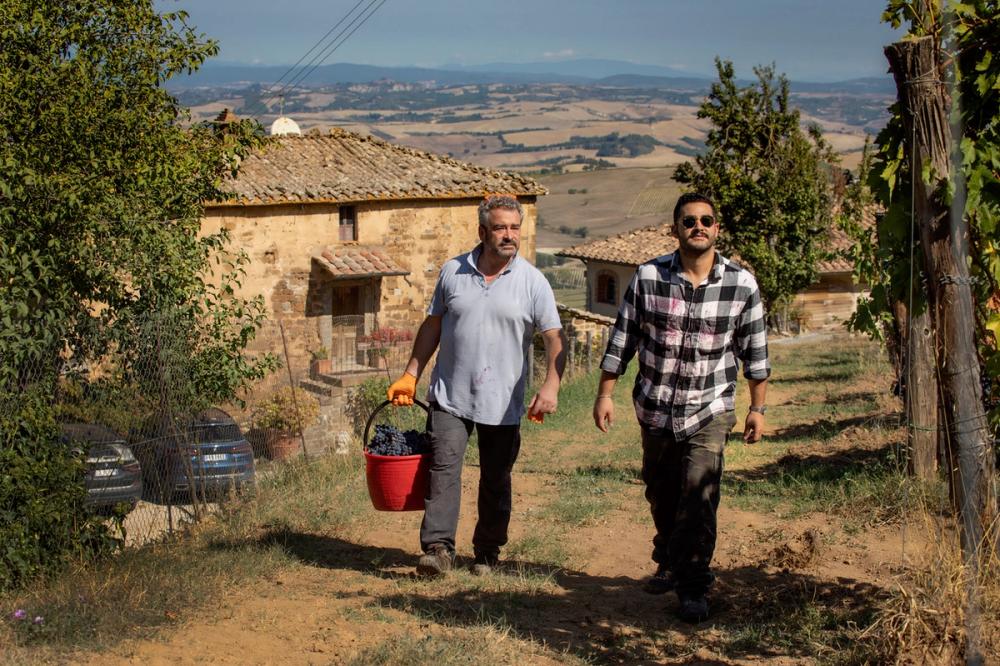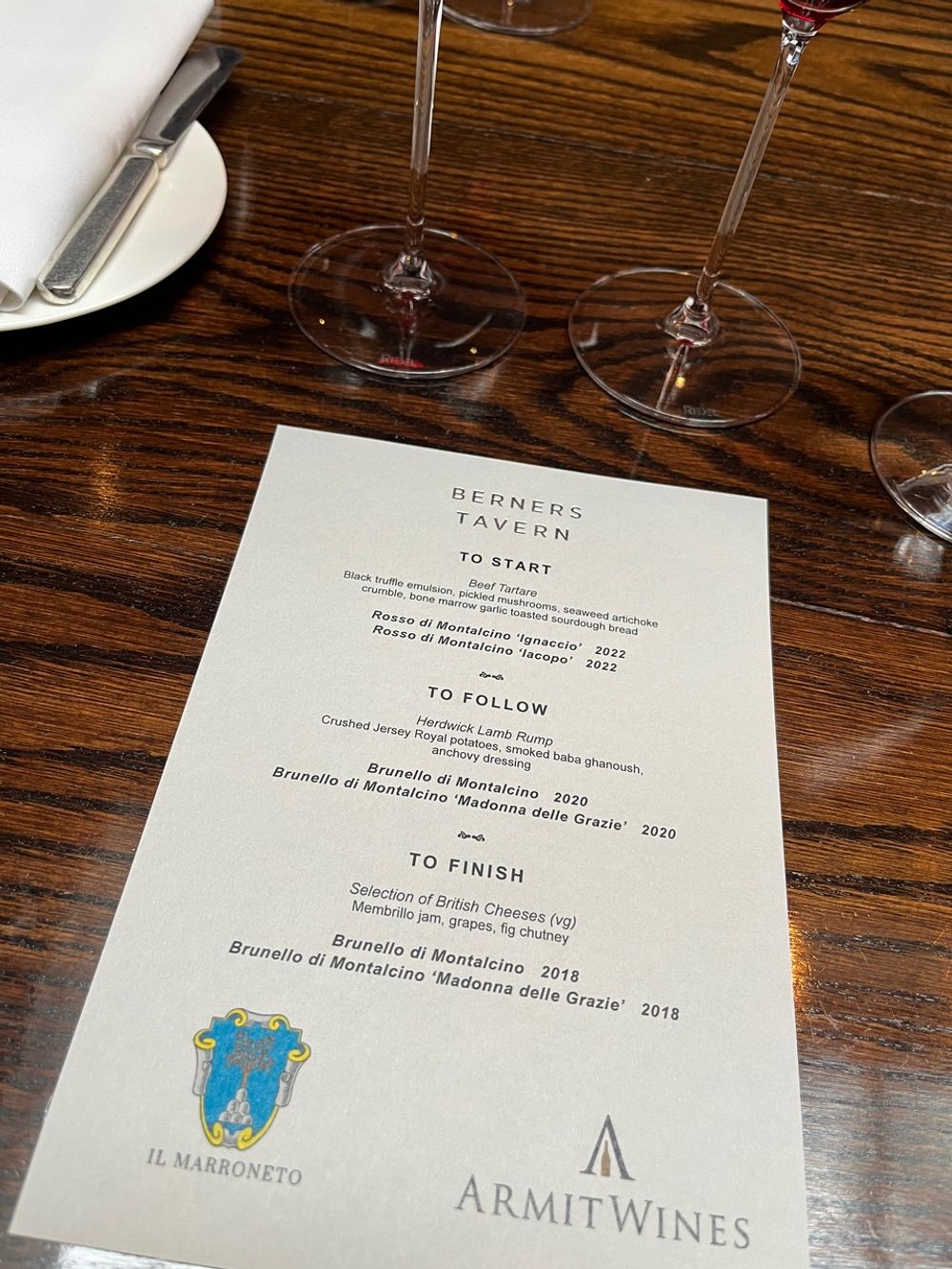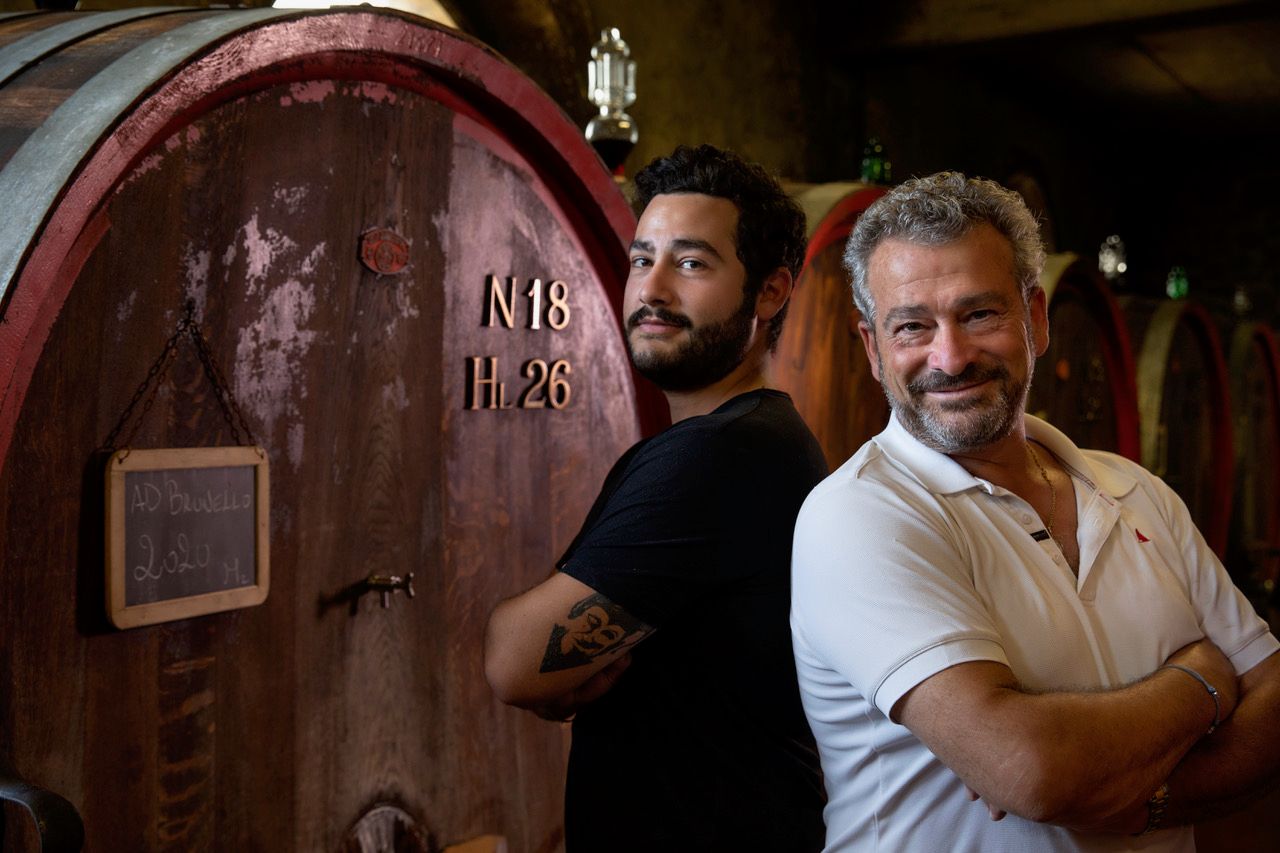Alessandro Mori was in characteristically animated form. After guiding sommeliers through an extensive vertical tasting, he arrived at Berners Tavern slightly late, accompanied by his son Iacopo, who has been involved in the winery since 2019.
Change has come to Montalcino, with a number of prominent names now under the control of investors and private shareholders. “All the people who were there with us between 1975 and 1985, they have died, and the farm is sold,” Mori lamented. “Diego Molinari at Cerbaiona, Piero Palmucci at Poggio di Sotto, Biondi Santi… the philosophy of making the wine has changed.”

“I wept blood in those years. Many journalists didn’t understand the wines, and importers didn’t want to deal with producers making less than half a million bottles.”Alessandro Mori at Berners Tavern, London, November 2024
That sentiment does not apply to Il Marroneto, which Mori's father, Giuseppe, acquired in 1974 – the same year Gianfranco Soldera established himself at Case Basse. The estate began experimenting with wine in 1975, with the first commercial vintage released in 1980. Vineyards were planted in 1975, 1979 and 1984 and have always been farmed with traditional practices.
"We are not biodynamic, we are not biological; we are traditional and natural,” Mori explained. “When we started, there wasn’t any machine or chemical to help make wine, so we learned to respect nature.”
The fundamentals of making wine were instilled by consultant Mario Cortevesio during the estate’s first decade, who had also worked with Sergio Manetti at Montevertine on the early vintages of Pergole Torte. From 1985 until 1994, Giulio Gambelli, the patron saint of Sangiovese, guided the winery.

Alessandro's son, Iacopo, joined the business in 2019 and is committed to preserving the estate’s traditions.
Il Marroneto’s approach is based on wild yeasts, natural fermentations (often at high temperatures), use of press wine and avoidance of practices like green harvesting and leaf thinning in the vineyard.
“We try not to manipulate production in any way. Nature knows better than we do how much fruit the vine should produce and we must respect that,” said Mori.
Vinification is done by parcel, with an emphasis on maintaining acidity. “Acidity is the secret to long life. It’s the pillar that allows the wine to endure after four years in barrel,” he added.
The estate’s northerly position, rather sandy soils and 420 metres of elevation help to conserve perfume and acidity in the wines, an element that has challenged many producers in an era of warmer vintages. To this end, the Mori family maintains traditional viticultural practices like accapannamento, a vine-training technique that tucks long shoots under the top wire rather than pruning them. Once considered outdated, this technique now offers a natural defence for the grapes against excess sun.
While these methods may align with modern trends, they were not popular thirty years ago. During the Brunello boom of the 1990s, Il Marroneto’s classical style was out of step with the market. “Critics said there was no colour, no aroma, too much acidity,” Mori recalled. “I wept blood in those years. Many journalists didn’t understand the wines, and importers didn’t want to deal with producers making less than half a million bottles.”
But Mori persisted with the old ways. In 1994, after a banking career in Rome, he was drawn back by his connection to the land. But rather than make changes, he continued to work in a way that defied the market, or, as he put it, “according to the knowledge and methods of our grandfathers.”
His son, Iacopo, joined the family business officially in 2019 and, like his father, Iacopo is committed to preserving the estate’s traditions. “We try to make every year just a little better than the last,” he said. “But I haven’t changed anything.” Given the tremendous quality of the wines here, that’s not entirely surprising.
The Wines

The line-up for the tasting lunch at Berners Tavern
The tasting featured four new releases: the 2022 Rossos and the 2020 Brunellos, alongside the 2018 Brunellos poured for comparison.
The 2020 vintage, shaped by erratic weather, was described as “extreme.” But, despite the challenges of COVID-19, the Moris managed their contiguous estate efficiently. Unlike producers with scattered holdings, quite common in Montalcino, they could maintain close oversight on their fruit. Perhaps controversially, both Alessandro and Iacopo believe the 2020 vintage surpasses the highly-praised 2019. “2020 will be eternal, much greater than 2019,” Iacopo predicted.
The 2022 vintage, on the other hand, was warm, dry and steady, with ripe fruit well-suited to the production of Rosso di Montalcino.
Rosso di Montalcino Ignaccio 2022
“We don’t know which grape will be Rosso or Brunello till the moment of the blending for the new vintage,” Iacopo says, “but it’s easy to make the decision: the barrels for the Rosso are ready earlier than the barrels of the Brunello.”
At Il Marroneto, the Rosso remains a cellar selection, although, inevitably, certain sites tend to always turn up in the Rosso. Bright red fruits mark the nose, which is perfumed, immediate, and striking. On the palate, rounded, ready tannins and tangy, citric acidity give appealing thrust and bite. An invigorating wine with impressive purity, and one of the very best Rossos in the region.
Rosso di Montalcino Iacopo 2022
Newly introduced by Iacopo in 2019, who says: “I wanted something in the middle between the Brunello and Rosso, something that you can drink without any problem from now, or you can forget in the cellar for 35 years.”
A selection by Iacopo of three to four barrels, giving a small production of around 3,000 bottles. A truly superb perfume of pure Sangiovese here: red cherry and orange zest on the lifted nose, terracotta and rose petal, and linear acidity. There’s a little more breadth of fruit than Ignaccio, and Iacopo 2022 also displays a stronger balsamic and cured meat note, and an extra dimension of tannin structure. On-trade only in the UK.
Brunello di Montalcino 2020
A truly classic expression of Brunello, highly territorial and pure. Lots of red and black cherries on the nose, concealing some bay leaf and resin notes, but incredibly expressive and inviting despite being bottled just four months ago. On the palate, this shows the relative openness of the 2020 vintage, with crisp acids and papery tannins framing concentrated fruit. Pristine and fine, this vintage from Il Marroneto is an exquisite combination of precision and power.
Brunello di Montalcino Madonna delle Grazie 2020
A small two-hectare plot acquired in 2000, the Madonna delle Grazie vineyard represented a new frontier under Alessandro Mori. The focus here is on gentle ferments and delicate extraction, unlike the Brunello annata, which seems a more classic, robust winemaking process.
In the glass, this is potently aromatic but extremely finessed, a beguiling combination of concentration and delicacy that’s hard to describe, but amazing to experience. Rose, cranberry, and sour red cherry segue into a palate that is a little closed but with profound balsamic notes, some smoky orange zest, and incredible length. Despite the delicate extraction, there are some substantial tannins here, and the vibrant acidity gives a pleasingly bone-dry, mineral-charged feel to the palate. Intense and very persistent, this is tight and will need some time in the cellar, but it’s undoubtedly one of the best wines of the vintage.
Brunello di Montalcino 2018
Evolved and open with soy and mushroom, in a refined and delicate style with a lightly rusty, ripe plum note. Very linear and seductive but with a touch of silky glycerol that smooths out the finish. Those tangy Il Marroneto acids are there underneath, along with a touch of cooked tomato. Lively and expressive, this is drinking extremely well now and may not necessarily improve in terms of complexity. Why wait?
Brunello di Montalcino Madonna delle Grazie 2018
Compared to the 2020 Madonna, this shows more evolution, with terracotta, blood, rust, and membrillo complementing the dried red fruits and pressed florals. Fine and delicate again, this still shows some tightness on the finish and will benefit from another year or two, but it is certainly starting to drink well. A notable shift from the intensity of the 2020, this is a very fine expression of a complicated year.
Il Marroneto is represented in the UK by Armit Wines which is a commercial partner of The Buyer. To discover more about them click here.
































